Not long ago, the only non-crop plant that the mainstream scientific community seemed to be aware of was the brassica Arabidopsis thaliana – easily cultivated, with a short generation time and small nuclear genome, it seemed the perfect plant model. The model moss Physcomitrella patens came along some years later, again with a short generation time and small genome and with easy protocols for cultivation, but with the addition of a haploid dominant lifecycle and the ability to undergo efficient homologous recombination. A far more recent addition to the pool of available model organisms is the complex thalloid liverwort Marchantia polymorpha. Like Physcomitrella, the haploid part of the plant’s lifecycle is dominant, the nuclear genome is small, the plants are easy to cultivate and fast growing, and there are established protocols to get them into sexual phases. Genetic transformation is also straightforward, and because the thalloid plant is haploid, the effects of mutations are easily visible and can be propagated via vegetative clones.
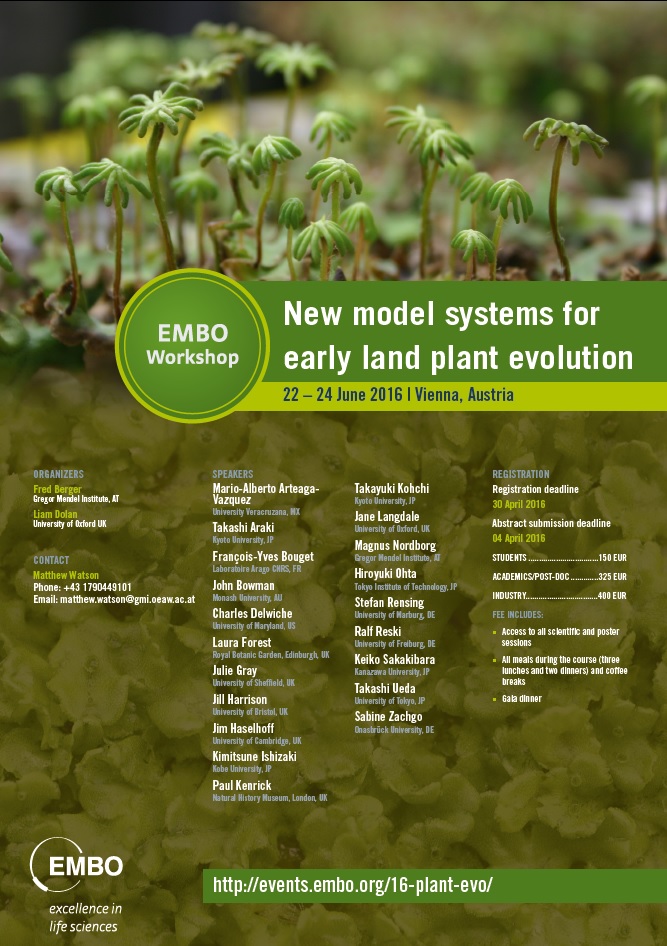 Indicative of its growing popularity as a model organism, the February 2016 edition of Plant and Cell Physiology, edited by Professors and , was a special focus edition on Marchantia polymorpha, while in June this year, EMBO hosted an international workshop on new model systems for early land plant evolution, wherein 21 of 36 speakers (58%) and 43 of 67 poster presenters (64%) mentioned Marchantia in their abstracts.
Indicative of its growing popularity as a model organism, the February 2016 edition of Plant and Cell Physiology, edited by Professors and , was a special focus edition on Marchantia polymorpha, while in June this year, EMBO hosted an international workshop on new model systems for early land plant evolution, wherein 21 of 36 speakers (58%) and 43 of 67 poster presenters (64%) mentioned Marchantia in their abstracts.
With publications starting to emerge from the longstanding RBGE project on the phylogeny of complex thalloid liverworts, we felt it was time to also explore some of the species level variation within genera. Previous published work from RBGE examines species relationships in other complex thalloid groups, Dumortiera, Cleveaceae and Mannia, while we are currently working on manuscripts for Sphaerocarpos and for the Aytonicaeae.
Considering the current levels of interest in Marchantia, and in light of our recent paper sinking both Preissia and Bugecia into the genus, we did a rapid survey of our silica-dried tissue and herbarium collections, to see how feasible it was to flesh out the sampling in our 2015 paper (which included about 8 species), to produce the first phylogeny for species of Marchantia. In 2013-2014, we extracted DNA from all our silica-dried tissue collections, and from many of the most recent herbarium collections, which in combination with sampling for our complex thalloid phylogeny, various EU-funded SYNTHESYS projects, and ongoing DNA barcoding work, meant that we now have DNA extracted from 169 Marchantia accessions, which have been determined to represent ca. 20 species, out of a total of 38 accepted species in the genus.
However, nearly 45% of the accessions (76) are detted as Marchantia polymorpha, as some of our previous work has focused on investigating the genetic differences between its three recognised subspecies, ruderalis (the common, weedy form), polymorpha (from damp natural habitats) and montivagans (frequently an upland plant). Most of the Marchantia polymorpha accessions are from the UK, but there are also samples from Ireland, Portugal, Sweden, Latvia, Switzerland, France, China, Malaysia, Pakistan, Tanzania, the US, Canada, Argentina, Ecuador and Peru.
The other species that we have extracted DNA for are M. alpestris, from Greenland; M. berteroana, from Chile and New Zealand; M. chenopoda, from Ecuador and Mexico; M. debilis from Cameroon, Ghana and South Africa; M. emarginata, from China and Japan; M. foliacea, from New Zealand; M. globosa, from Reunion; M. hartlessiana, from Bhutan, India and Nepal; M. inflexa, from Mexico; M. linearis, from Bhutan and Nepal; M. paleacea, from Italy, Portugal, the US, Mexico, Yemen, India, Bhutan, China and Japan; M. papillata from Bhutan, Bangladesh, Nepal, Rhodesia, Tanzania and Malawi; M. pappeana from Lesotho, Tanzania and Malawi; M. pinnata from Japan; M. plicata from Ecuador, and M. subintegra from Bhutan, India and Nepal.
In addition, we have accessions of Marchantia romanica (formerly Bucegia romanica) from Romania and Slovakia, and accessions of Marchantia quadrata (formerly Preissia quadrata), from the UK, Ireland, France, Germany, Sweden, Norway, the Czech Republic, China and the US.
The choice of which DNA regions would be best to work with was straightforward – given that many of our DNA extractions were from herbarium specimens, we were limited to short regions of sequence, and to regions that are present in multiple copies within the plant genome – effectively, plastid and nuclear ribosomal regions. When specimens are preserved for the herbarium, the quality of their DNA drops considerably compared to fresh material; eventually it can break into many short fragments. In order to make copies of regions of DNA using standard laboratory PCR methods, there has to be an unbroken piece of DNA to act as the template, and the shorter the region that’s being copied, and the more copies of it that are present in the genome, the more likely it is to work. Because we routinely sequence the two standard plant DNA barcode loci, from the plastid rbcL and matK genes, and two supplementary DNA barcode regions, the plastid psbA-trnH spacer region and the nuclear ribosomal spacer ITS2, these relatively short regions were obvious choices. However, we found two of these regions, matK and ITS2, consistently problematic to amplify and to sequence for Marchantia polymorpha, and so decided to focus on just the rbcL and psbA-trnH regions for this initial study.
References:
David G. Long. 2010. Marchantia polymorpha subsp. montivagans/polymorpha/ruderalis, in: Atherton, Bosanquet & Lawley, Mosses and Liverworts of Britain and Ireland a field guide, British Bryological Society.
David G. Long, Laura L. Forrest, Juan Carlos Villarreal & Barbara J. Crandall-Stotler. 2016. Taxonomic changes in Marchantiaceae, Corsiniaceae and Cleveaceae (Marchantiidae, Marchantiophyta). Phytotaxa 252 (1): 077-080.
Juan Carlos Villarreal, Barbara J. Crandall-Stotler, Michelle L. Hart, David G. Long & Laura L. Forrest. 2015. Divergence times and the evolution of morphological complexity in an early land plant lineage (Marchantiopsida) with a slow molecular rate. New Phytologist. 209: 1734–46, doi: 10.1111/nph.13716.
Relevant posts:
A rapid phylogeny of Marchantia, from the RBGE collections. I. Sampling
A rapid phylogeny of Marchantia, from the RBGE collections. II. Illuminating our sampling

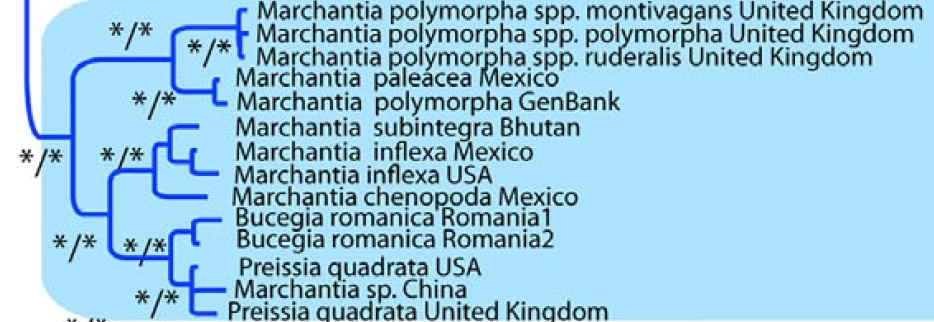
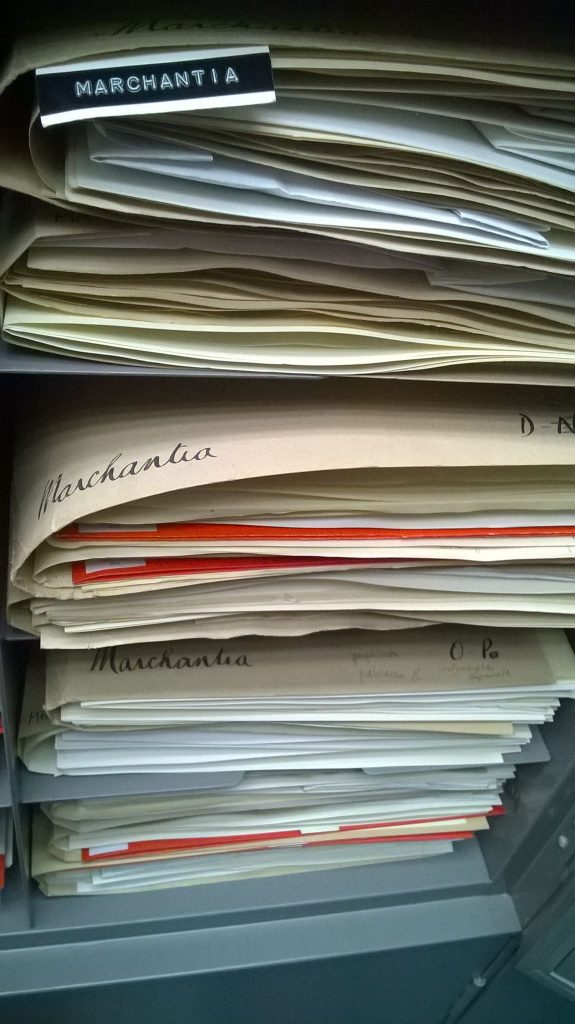
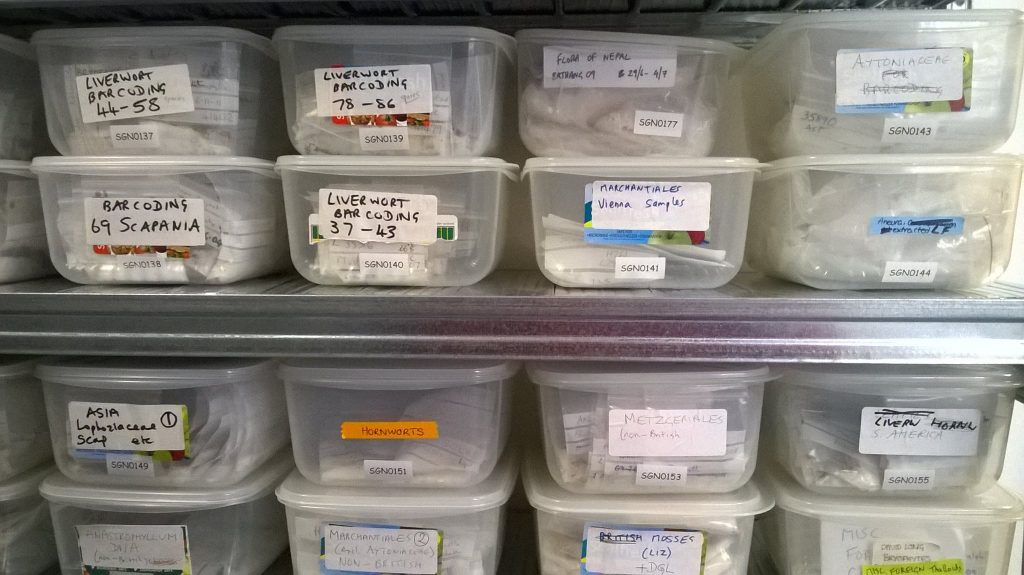

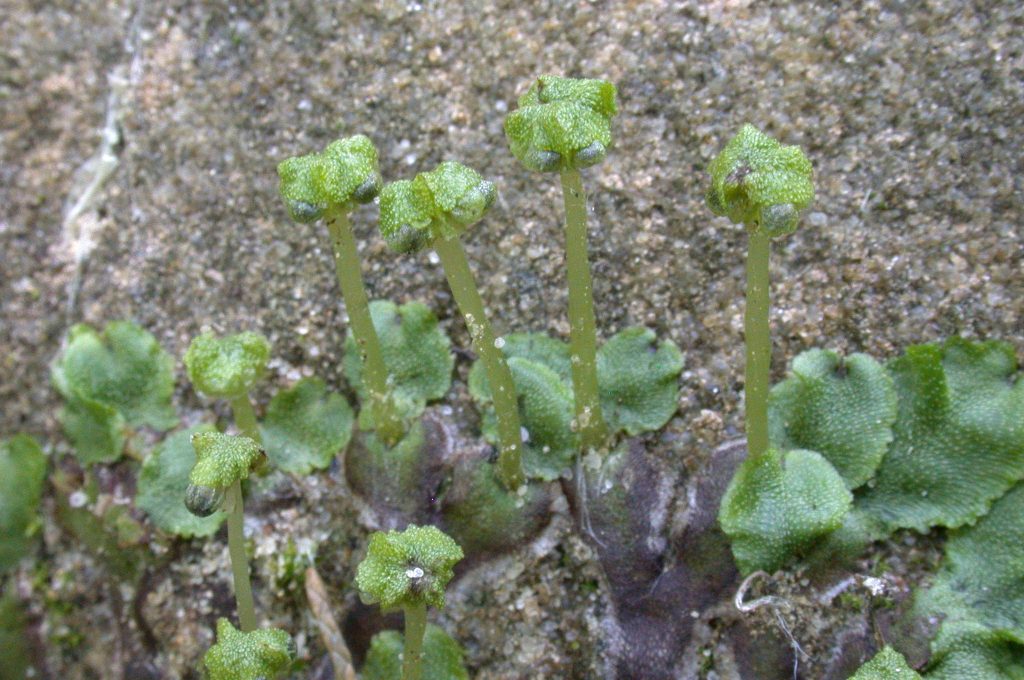
Cymon
“A far more recent addition to the pool of available model organisms is the complex thalloid liverwort Marchantia polymorpha.”
Nah, Marchantia’s been a model for years… wasnt it one of the first to have it’s chloroplast genome sequenced sometime in the 80’s? I guess it’s how you define what a model organism is… other than it being a name that you attach to your organism of choice because it sounds good to reviewers when you submit your paper… (apologies for the cynicism)
Laura Forrest
I think, My Cynic, that you’ll find that the second organism (after rice) to have its organellar genomes sequenced was in fact Marchantia paleacea, not Marchantia polymorpha… But otherwise you may not be entirely wrong, except that the scale of some of the current evo-devo projects on Marchantia absolutely astounds me.
Cymon
Well, not quite – the orginal sequence (1984 Ohyama,K X04465.1) was indeed submitted with the taxonomy Marchantia paleacea, but the Reference Sequence (NC_001319.1) for Marchantia polymorpha is the same data and submission but with a different taxonomy. So somewhere down the line, someone decided either M. paleacea == M. polymorpha, or the original id was wrong… I guess the later if you are saying they are different species…
Laura Forrest
tut tut tut… you clearly haven’t read our paper 🙂 See Villarreal et al. 2015, New Phytologist. 209: 1734–46 or just go to http://stories.rbge.org.uk/archives/17708 – anyway, the GenBank IDs are wrong for the organelles, they’re both M. paleacea. There are now several datasets that show this quite clearly – see also the abstract here for poster #26 Resequencing the ‘classic’ Marchantia polymorpha chloroplast genome, Hanna Kijak, Michał Rurek, Witold Nowak, Mirosława Dabert, Ireneusz Odrzykoski http://events.embo.org/16-plant-evo/Abstract%20Book%20New%20model%20systems%20for%20early%20land%20plant%20%20evolution.pdf
Cymon
Ha! You’re right I havn’t been keeping up on the intracacies of Marchantia systematics 😉 Perhaps you could get NCBI to change the taxonmy of the record before more errors ensue…